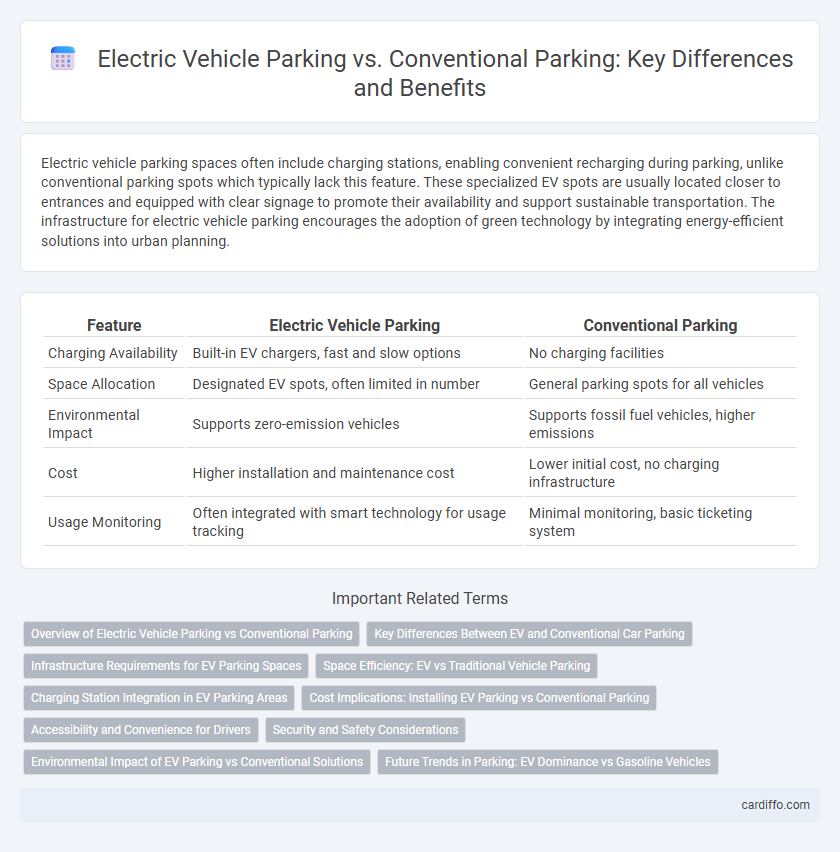Electric vehicle parking spaces often include charging stations, enabling convenient recharging during parking, unlike conventional parking spots which typically lack this feature. These specialized EV spots are usually located closer to entrances and equipped with clear signage to promote their availability and support sustainable transportation. The infrastructure for electric vehicle parking encourages the adoption of green technology by integrating energy-efficient solutions into urban planning.
Table of Comparison
| Feature | Electric Vehicle Parking | Conventional Parking |
|---|---|---|
| Charging Availability | Built-in EV chargers, fast and slow options | No charging facilities |
| Space Allocation | Designated EV spots, often limited in number | General parking spots for all vehicles |
| Environmental Impact | Supports zero-emission vehicles | Supports fossil fuel vehicles, higher emissions |
| Cost | Higher installation and maintenance cost | Lower initial cost, no charging infrastructure |
| Usage Monitoring | Often integrated with smart technology for usage tracking | Minimal monitoring, basic ticketing system |
Overview of Electric Vehicle Parking vs Conventional Parking
Electric vehicle parking requires specialized infrastructure, such as charging stations, which are often integrated with renewable energy sources to support sustainability goals. Conventional parking facilities primarily accommodate standard internal combustion engine vehicles and lack the necessary EV charging capabilities. The increasing demand for electric vehicle parking reflects the global shift towards cleaner transportation and urban planning adaptations.
Key Differences Between EV and Conventional Car Parking
Electric Vehicle (EV) parking requires dedicated charging infrastructure with Level 2 or DC fast chargers, while conventional car parking lacks power supply features. EV parking spaces often incorporate smart technology for energy management and reservation systems, contrasting with traditional parking's manual allocation. Additionally, EV spots are strategically located near power grids or solar panel installations to support sustainable energy use, unlike conventional parking that prioritizes general accessibility.
Infrastructure Requirements for EV Parking Spaces
Electric vehicle parking spaces demand specialized infrastructure, including high-capacity charging stations compatible with various EV models, reliable electrical grid connections, and enhanced safety features such as surge protection and fire-resistant materials. Conventional parking spaces require minimal electrical infrastructure, focusing primarily on physical space allocation and standard pavement durability. Integrating smart energy management systems and renewable energy sources further optimizes the efficiency and sustainability of EV parking infrastructure.
Space Efficiency: EV vs Traditional Vehicle Parking
Electric vehicle parking spaces often require more room than conventional parking due to the need for integrated charging infrastructure and clearance around charging ports. Traditional vehicle parking maximizes space efficiency by allowing tighter spacing without additional electrical equipment constraints. Urban planners must balance the growing demand for EV charging with optimizing overall parking capacity in dense areas.
Charging Station Integration in EV Parking Areas
Electric vehicle parking areas incorporate advanced charging station integration, ensuring seamless access to high-capacity chargers that deliver fast and efficient energy replenishment. These EV parking zones utilize smart grid technology to optimize power distribution and minimize charging time, supporting sustainable urban mobility. In contrast, conventional parking lacks dedicated charging infrastructure, limiting its functionality for electric vehicle users.
Cost Implications: Installing EV Parking vs Conventional Parking
Installing electric vehicle (EV) parking spaces incurs higher upfront costs due to the need for specialized charging infrastructure, electrical upgrades, and ongoing maintenance of charging stations. Conventional parking spaces generally require lower installation expenses as they lack the complex electrical components associated with EV chargers. Over time, however, EV parking can offer cost savings through incentives, increased property value, and alignment with sustainability goals.
Accessibility and Convenience for Drivers
Electric vehicle parking offers enhanced accessibility through dedicated charging stations strategically located in high-demand areas, enabling drivers to recharge while parked. Conventional parking lacks integrated charging infrastructure, limiting convenience for electric vehicle users who must seek separate charging points. The convenience of electric vehicle parking is further improved by features like reserved spots and real-time availability updates, streamlining the parking experience for EV drivers.
Security and Safety Considerations
Electric vehicle parking requires enhanced security measures such as surveillance for charging stations to prevent theft and vandalism of expensive batteries, whereas conventional parking prioritizes guard patrols and physical barriers. Safety considerations for electric vehicle parking include proper ventilation to mitigate fire hazards from battery malfunctions, alongside emergency shutoff systems, contrasting with conventional parking's emphasis on structural integrity and lighting. Integrated security technologies like smart locks and real-time monitoring optimize EV parking safety, setting it apart from traditional parking lot surveillance methods.
Environmental Impact of EV Parking vs Conventional Solutions
Electric vehicle (EV) parking significantly reduces carbon emissions compared to conventional parking, which supports internal combustion engine vehicles that emit greenhouse gases. EV parking facilities often integrate renewable energy sources and smart charging infrastructure, minimizing the overall environmental footprint. In contrast, traditional parking contributes to air pollution and urban heat islands due to the prevalence of fossil fuel vehicles and lack of sustainable energy integration.
Future Trends in Parking: EV Dominance vs Gasoline Vehicles
Electric vehicle parking infrastructure is rapidly expanding due to surging EV adoption and government incentives targeting carbon emission reductions. Conventional gasoline vehicle parking is expected to decline as urban planning integrates smart charging stations and prioritizes sustainable transportation solutions. Future parking trends emphasize EV dominance, with smart sensors, automated charging, and dynamic space allocation becoming standard in modern parking facilities.
Electric Vehicle Parking vs Conventional Parking Infographic

 cardiffo.com
cardiffo.com